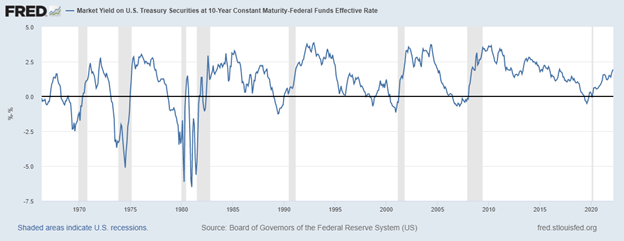In a speech to the International Monetary Fund, Federal Reserve Chair Jerome Powell confirmed that the central bank was almost certain to raise interest rates by 0.5% at its next meeting.
According to The Wall Street Journal, Powell said: “It is appropriate in my view to be moving a little more quickly to raise interest rates than the Fed has in the recent past. I also think there’s something in the idea of front-end-loading the removal of stimulus.”
Futures traders expected the half-point increase. The probability of that size hike increased to 99.8% from 93.8%. There were similar gains in the probabilities of a half-point hike for each of the next few meetings.
Based on futures prices, by the end of September, the federal funds rate should be at least 2.25% because the forecasts are based on market prices. Traders are betting real dollars that rates will soar.
As short-term rates rise, long-term rates should also rise.
The chart below shows the spread between the fed funds rate and 10-year Treasury notes. It’s typically about 1.5% but can be significantly more or less.
Rising Bond Prices Suggest Increased Mortgage Rates

Source: Federal Reserve.
Short-Term Rate Increases Balance Mortgage Peak
Looking at the current environment, 10-year Treasurys are at about 2.9%. Using a spread of 1.5%, that rate could rise to 3.75% by September.
Mortgages are typically about 1.5% higher than the 10-year, which means mortgages may hold near 5% through the summer.
That’s good news for the housing market, but there are risks.
These estimates are based on history. But this time is different.
The Fed will also sell off assets on its $9 trillion balance sheet. Selling bonds will increase their supply. The law of supply and demand tells us that increased supply will drive down the prices of bonds. And as prices fall, rates rise.
That increases the likelihood of rates overshooting their targets. Offsetting that risk is that higher rates will slow the economy and reduce demand for bonds.
On balance, short-term rates will certainly rise, but long-term rates and mortgages may be near their cycle peaks.
Michael Carr is the editor of True Options Masters, One Trade, Peak Velocity Trader and Precision Profits. He teaches technical analysis and quantitative technical analysis at the New York Institute of Finance. Follow him on Twitter @MichaelCarrGuru.





